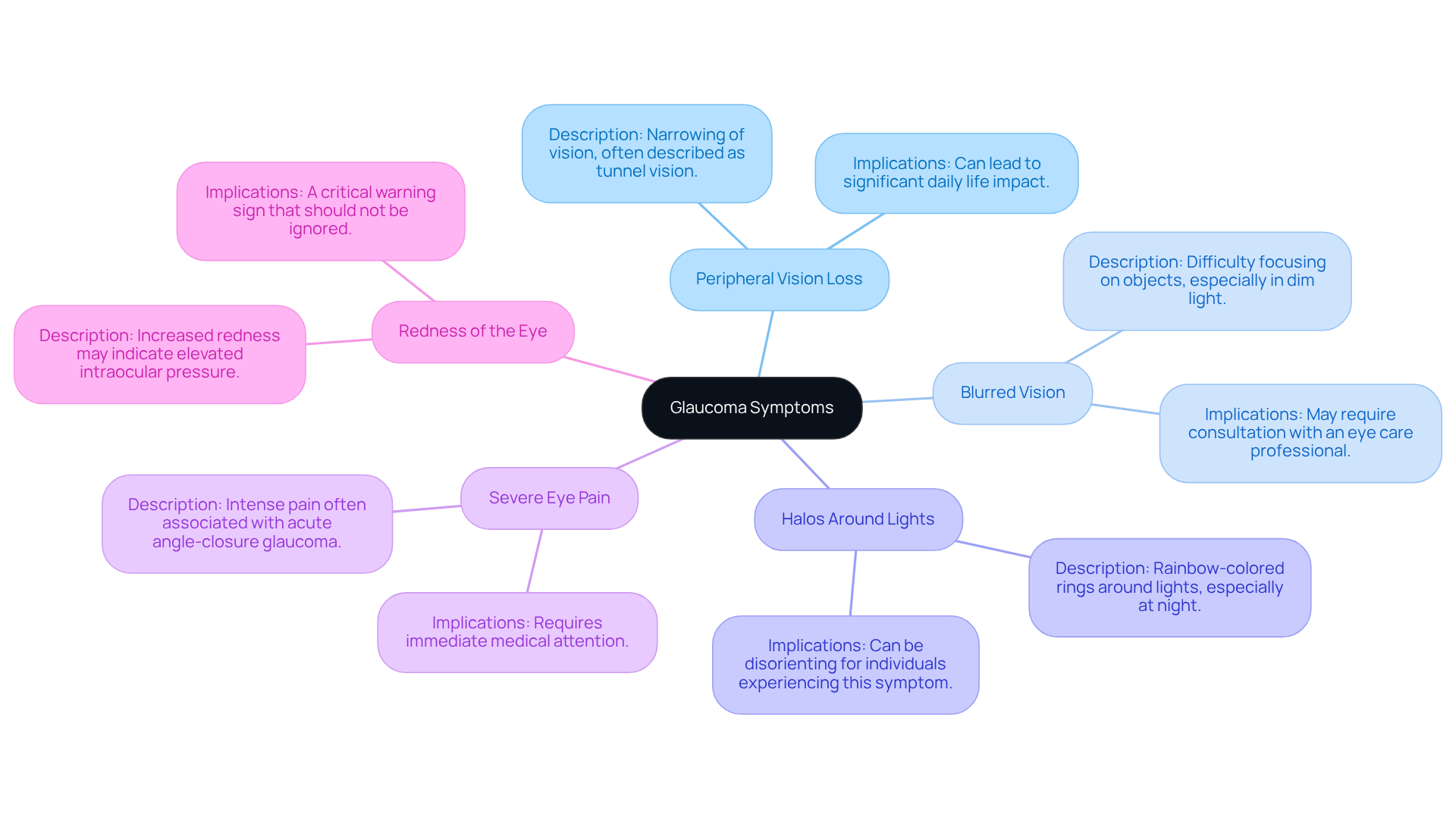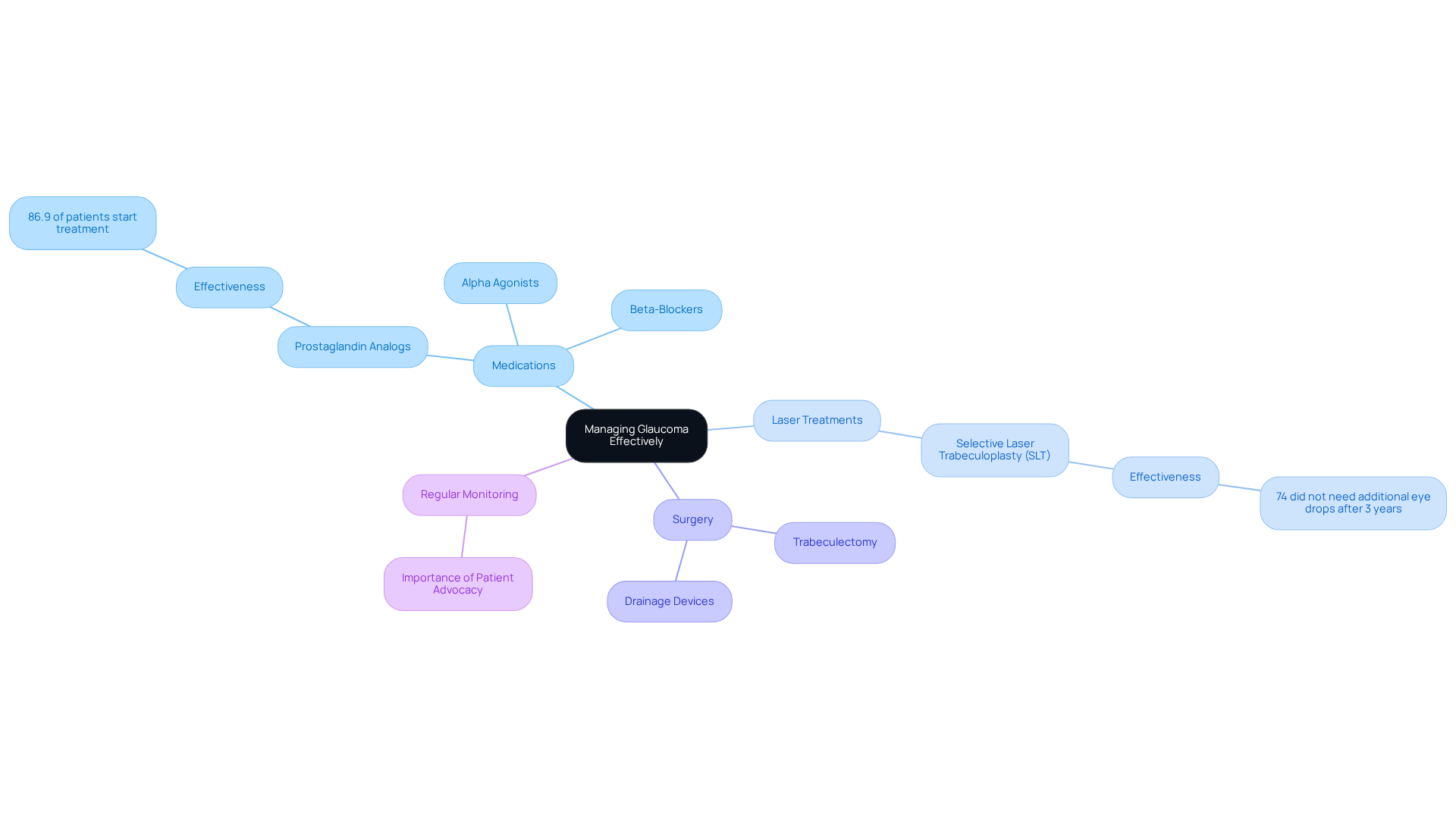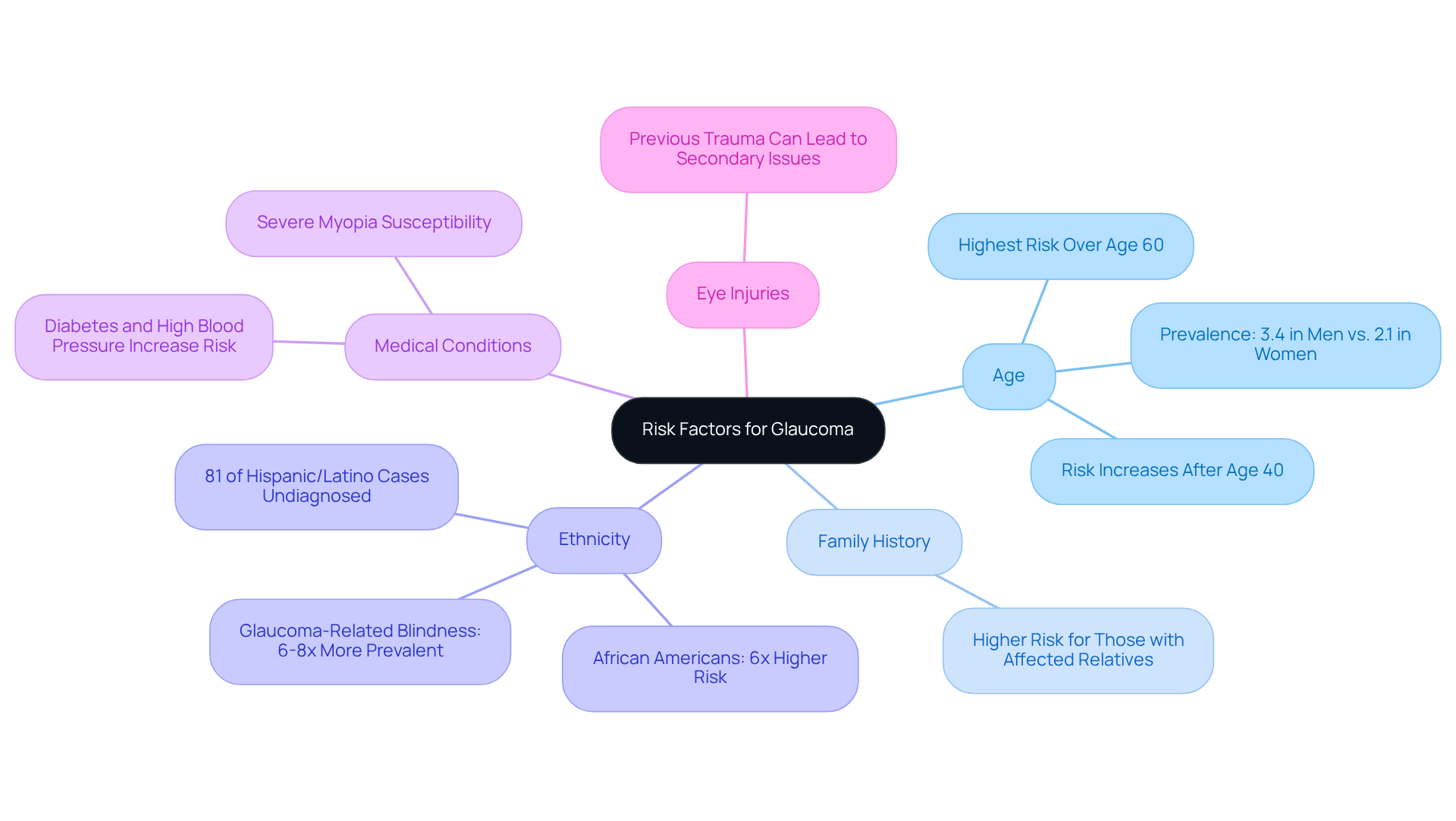Posted by: Northwest Eye in General, Glaucoma on November 8, 2025
Overview
Glaucoma is more than just a medical term; it’s a group of eye conditions that can deeply affect your vision. This condition damages the optic nerve, primarily due to elevated intraocular pressure (IOP). There are various types of glaucoma, including:
- Open-angle
- Angle-closure
- Normal-tension
- Congenital
- Secondary glaucoma
We understand that learning about glaucoma can be overwhelming. That’s why it’s crucial to emphasize the importance of early detection and effective management. Treatments such as:
- Medications
- Laser therapies
- Surgery
can make a significant difference. Timely intervention can greatly reduce the risk of irreversible vision loss, especially for those in high-risk groups, like older adults and certain ethnic populations.
It’s common to feel anxious about what this means for you or your loved ones. But remember, you’re not alone in this journey. Many patients have successfully navigated their treatment paths, and we are here to help you through this process.
If you have concerns about your eye health, please don’t hesitate to reach out for support. Early action can lead to better outcomes, and we’re committed to guiding you every step of the way.
Introduction
Understanding glaucoma is crucial. This condition encompasses a range of eye issues that can silently threaten your vision by damaging the optic nerve. With millions affected, recognizing symptoms, identifying risk factors, and exploring available treatments is vital. We understand that navigating this complex landscape can feel overwhelming. How can you effectively safeguard your eye health and prevent irreversible damage?
This article delves into the essentials of glaucoma, providing insights into its types, symptoms, risks, and the latest treatment options available. We are here to help you through this process, ensuring you feel informed and supported every step of the way.
Define Glaucoma: Types and Overview
Glaucoma eye refers to a collection of eye conditions that can harm your optic nerve, often due to elevated intraocular pressure (IOP). We understand that hearing about eye health can be concerning, so let’s explore the different types of glaucoma together:
-
Open-Angle Glaucoma: This is the most common form, where eye pressure gradually increases, leading to peripheral vision loss. It accounts for about 90% of glaucoma cases, making it a significant concern for eye health.
-
Angle-Closure Glaucoma Eye: This occurs when the drainage angle of the glaucoma eye becomes blocked, leading to a rapid increase in eye pressure. It can come with severe symptoms like intense eye pain, headaches, and nausea. Timely intervention is crucial in managing glaucoma eye conditions, as successful management can make a big difference.
-
Normal-Tension Glaucoma: Here, damage to the optic nerve happens even with normal eye pressure, possibly due to reduced blood flow. This complexity highlights the importance of personalized glaucoma management.
-
Congenital Glaucoma: A rare form present at birth, often due to abnormal eye development. Early identification and action are essential to prevent sight impairment, and we’re here to support you through that process.
-
Secondary Glaucoma: This type results from other medical conditions or medications that increase eye pressure. Understanding the underlying causes of glaucoma eye is vital for effective treatment.
Recent studies show that early detection and proactive management of glaucoma can significantly reduce the risk of irreversible vision loss. For example, in 2022, an estimated 4.2 million Americans were living with this condition, with a prevalence of 1.62% among adults aged 18 and older. It’s important to note that Black individuals are disproportionately affected, with a prevalence of 3.15% compared to 1.42% among White adults.
As research continues to evolve, new treatment options and insights into different forms of eye pressure disorders are being explored. We encourage you to stay informed and seek regular eye check-ups. Remember, you’re not alone in this journey; we are here to help you through the process.

Identify Symptoms: Recognizing Glaucoma Indicators
The glaucoma eye often develops silently in its early stages, making awareness of its symptoms vital for timely intervention. We understand that recognizing these signs can be concerning, but knowing what to look for can empower you to take action. As the disease advances, individuals may notice several key indicators:
- Peripheral Vision Loss: This is frequently the first noticeable symptom, leading to a narrowing of vision, often described as tunnel vision. It’s common to feel alarmed by this change, and studies indicate that a significant percentage of patients experience this loss as the condition progresses.
- Blurred Vision: You might struggle to focus on objects, particularly in dim lighting conditions, which can be frustrating and alarming. It’s important to talk to your eye care professional if this happens.
- Halos Around Lights: Many individuals report seeing rainbow-colored rings around lights, especially noticeable at night. This can be disorienting, and we want you to know that you’re not alone in experiencing this.
- Severe Eye Pain: In cases of acute angle-closure glaucoma, symptoms can escalate to intense eye pain, often accompanied by headaches and nausea. If you experience this, please seek immediate medical attention.
- Redness of the Eye: Increased redness may signal elevated intraocular pressure, a critical warning sign that should not be ignored.
Identifying these symptoms is crucial for obtaining timely medical assessment and care for the glaucoma eye, which can greatly assist in maintaining sight and averting permanent harm. Testimonials from patients highlight the profound impact of peripheral vision loss on daily life, underscoring the need for regular eye examinations and proactive management of eye health. Remember, we are here to help you through this process.

Explore Treatments: Managing Glaucoma Effectively
While there’s no cure for this eye condition, we want you to know that effective management can significantly slow its progression. Here are some treatment options that may help:
-
Medications: Prescription eye drops are often the first line of treatment to lower intraocular pressure (IOP). Common medications include prostaglandin analogs, beta-blockers, and alpha agonists. It’s reassuring to note that recent studies show about 86.9% of patients start treatment with prostaglandin analogs due to their effectiveness in lowering IOP.
-
Laser Treatments: Procedures like Selective Laser Trabeculoplasty (SLT) have become popular as a first-line treatment for mild open-angle glaucoma (OAG). SLT can enhance fluid drainage from the eye, effectively lowering tension. Research indicates that 74% of patients treated with SLT didn’t need additional eye drops after three years, showcasing its long-term efficacy.
-
Surgery: If medications and laser treatments aren’t effective, surgical options such as trabeculectomy or the implantation of drainage devices may be considered. These procedures aim to create openings for fluid to escape, thereby reducing eye tension. Surgical interventions can effectively manage eye pressure, with trabeculectomy and tube shunt surgery being common procedures.
-
Regular Monitoring: Continuous follow-up with an ophthalmologist is crucial to assess how well your treatment is working and to make any necessary adjustments. As Dr. Lucy Q. Shen emphasizes, you are your best advocate for detecting changes in your condition between visits. This highlights the importance of being proactive in your care.
We encourage you to discuss all available options with your healthcare provider to determine the best plan of action tailored to your specific condition. Together, we can ensure a customized strategy for managing your eye health effectively.

Assess Risk Factors: Who is at Risk for Glaucoma?
Several factors can significantly increase the risk of developing glaucoma, making awareness and proactive care essential for your eye health:
-
Age: We understand that as we age, our health concerns can grow. The risk of glaucoma escalates notably after age 40, with individuals over 60 facing the highest likelihood of developing the condition. Statistics show that the occurrence of eye disease was 3.4% in men compared to 2.1% in women, emphasizing the importance of regular screenings for older adults.
-
Family History: It’s common to feel concerned if you have a family history of eye pressure issues. Studies indicate that individuals with relatives affected by the disease are more likely to develop it themselves, underscoring the need for heightened vigilance among those with a familial predisposition.
-
Ethnicity: Certain ethnic groups face greater risks. For instance, African Americans experience eye pressure conditions at rates six times higher than Caucasians. Moreover, glaucoma-related blindness is 6 to 8 times more prevalent in African Americans than in Caucasians. The situation is also troubling among Hispanic populations, as a 2016 study revealed that 81% of eye conditions among Hispanic or Latino individuals remain undiagnosed and untreated. This highlights the significance of awareness and regular eye examinations for this group.
-
Medical Conditions: Chronic conditions such as diabetes and high blood pressure can increase the risk of eye damage. If you have severe myopia, you may also be at increased susceptibility, making it crucial to undergo regular eye examinations.
-
Eye Injuries: We understand that previous trauma to the eye can lead to secondary vision issues. This further emphasizes the need for monitoring and care following any eye injuries.
Understanding these risk factors is vital for early detection and intervention. Regular eye exams are critical for those at higher risk, as they can facilitate timely diagnosis and management of glaucoma. This ultimately protects your vision and enhances your quality of life. Remember, we are here to help you through this process.

Conclusion
Understanding glaucoma is crucial for preserving vision and maintaining quality of life. We understand that facing such a diagnosis can be overwhelming, but knowledge is power. This article has explored the various types of glaucoma, including:
- Open-angle glaucoma
- Angle-closure glaucoma
- Normal-tension glaucoma
- Congenital glaucoma
- Secondary glaucoma
Each type presents unique challenges, and recognizing these differences is essential for effective management and treatment.
Key symptoms such as:
- Peripheral vision loss
- Blurred vision
- Halos around lights
- Severe eye pain
- Redness of the eye
serve as critical indicators that should not be overlooked. It’s common to feel anxious about these signs, but early detection is vital. The importance of timely intervention cannot be overstated, as it can significantly reduce the risk of irreversible vision loss. Additionally, we highlighted various treatment options, including:
- Medications
- Laser treatments
- Surgical interventions
emphasizing the need for regular monitoring and personalized care.
In conclusion, raising awareness about glaucoma, its symptoms, risks, and treatments is vital for fostering proactive eye health. Regular eye check-ups and understanding personal risk factors can empower you to take charge of your vision. By staying informed and advocating for eye health, we can all contribute to a future with better outcomes for those affected by glaucoma. Remember, we are here to help you through this process.
Frequently Asked Questions
What is glaucoma?
Glaucoma refers to a collection of eye conditions that can harm the optic nerve, often due to elevated intraocular pressure (IOP).
What are the main types of glaucoma?
The main types of glaucoma include Open-Angle Glaucoma, Angle-Closure Glaucoma, Normal-Tension Glaucoma, Congenital Glaucoma, and Secondary Glaucoma.
What is Open-Angle Glaucoma?
Open-Angle Glaucoma is the most common form of glaucoma, where eye pressure gradually increases, leading to peripheral vision loss. It accounts for about 90% of glaucoma cases.
What are the symptoms of Angle-Closure Glaucoma?
Angle-Closure Glaucoma can cause severe symptoms such as intense eye pain, headaches, and nausea due to a rapid increase in eye pressure.
What is Normal-Tension Glaucoma?
Normal-Tension Glaucoma is a type of glaucoma where damage to the optic nerve occurs even with normal eye pressure, possibly due to reduced blood flow.
What is Congenital Glaucoma?
Congenital Glaucoma is a rare form present at birth, often due to abnormal eye development. Early identification and action are essential to prevent sight impairment.
What causes Secondary Glaucoma?
Secondary Glaucoma results from other medical conditions or medications that increase eye pressure.
How prevalent is glaucoma in the United States?
In 2022, an estimated 4.2 million Americans were living with glaucoma, with a prevalence of 1.62% among adults aged 18 and older.
Are certain populations more affected by glaucoma?
Yes, Black individuals are disproportionately affected by glaucoma, with a prevalence of 3.15% compared to 1.42% among White adults.
Why is early detection and management of glaucoma important?
Early detection and proactive management of glaucoma can significantly reduce the risk of irreversible vision loss. Regular eye check-ups are encouraged for effective monitoring and treatment.






